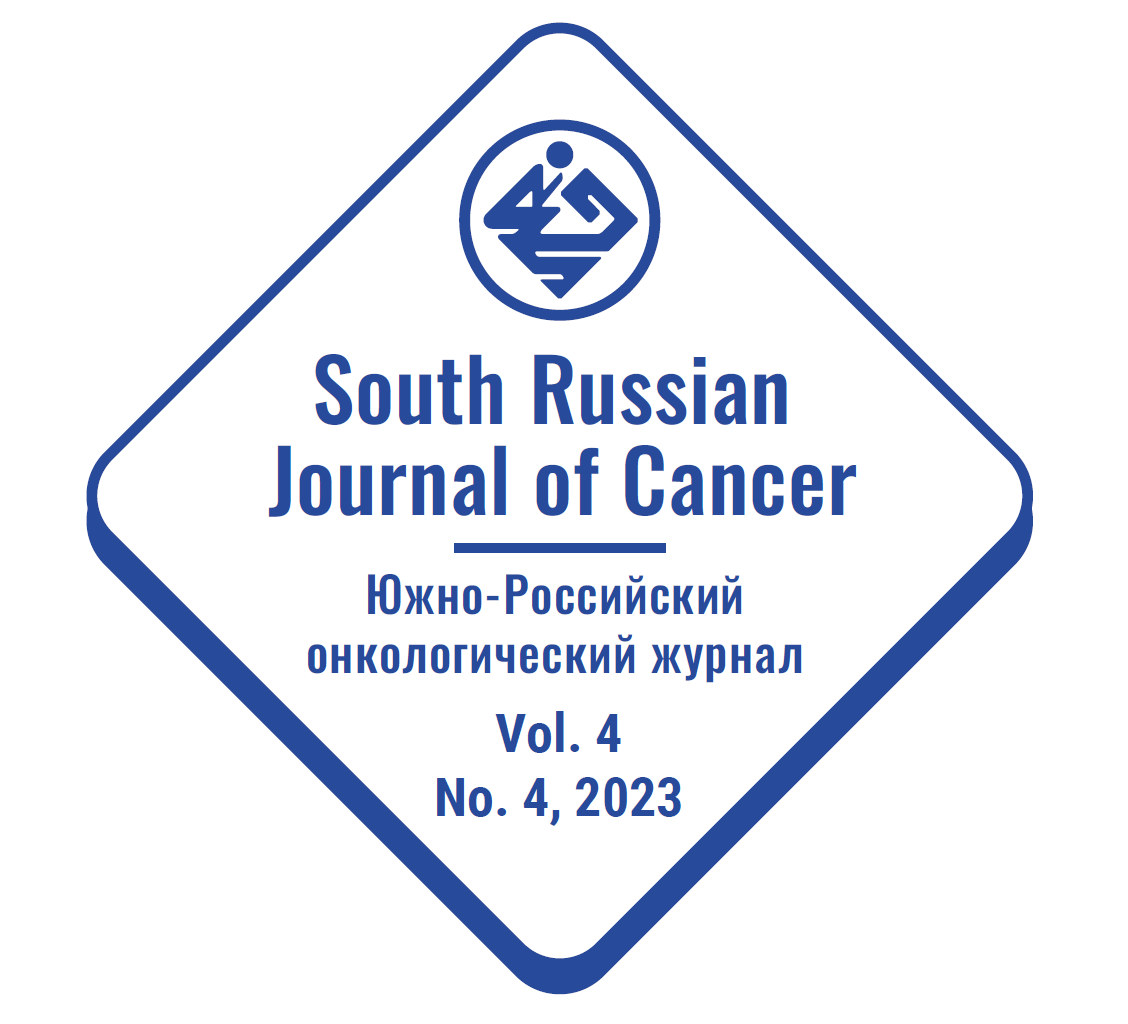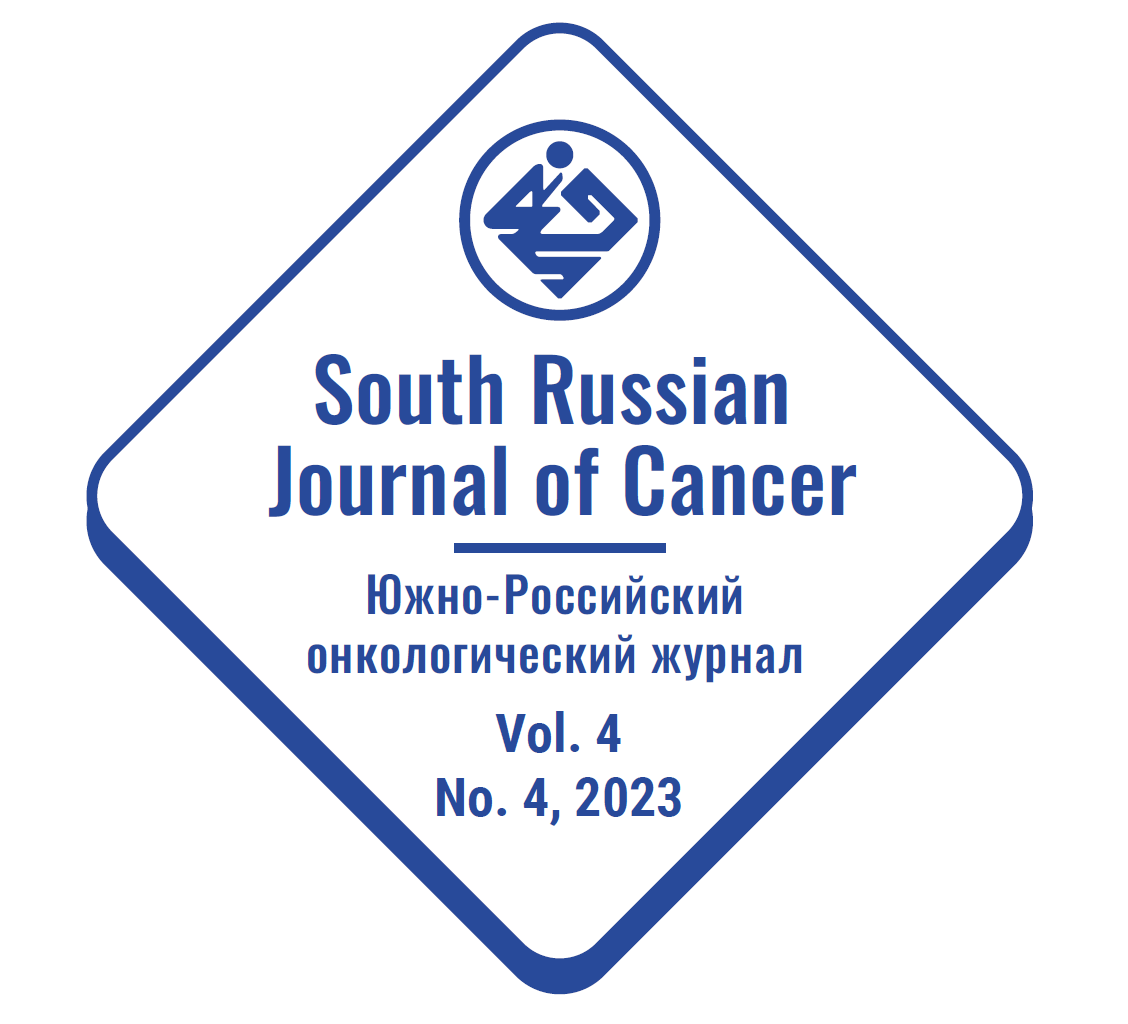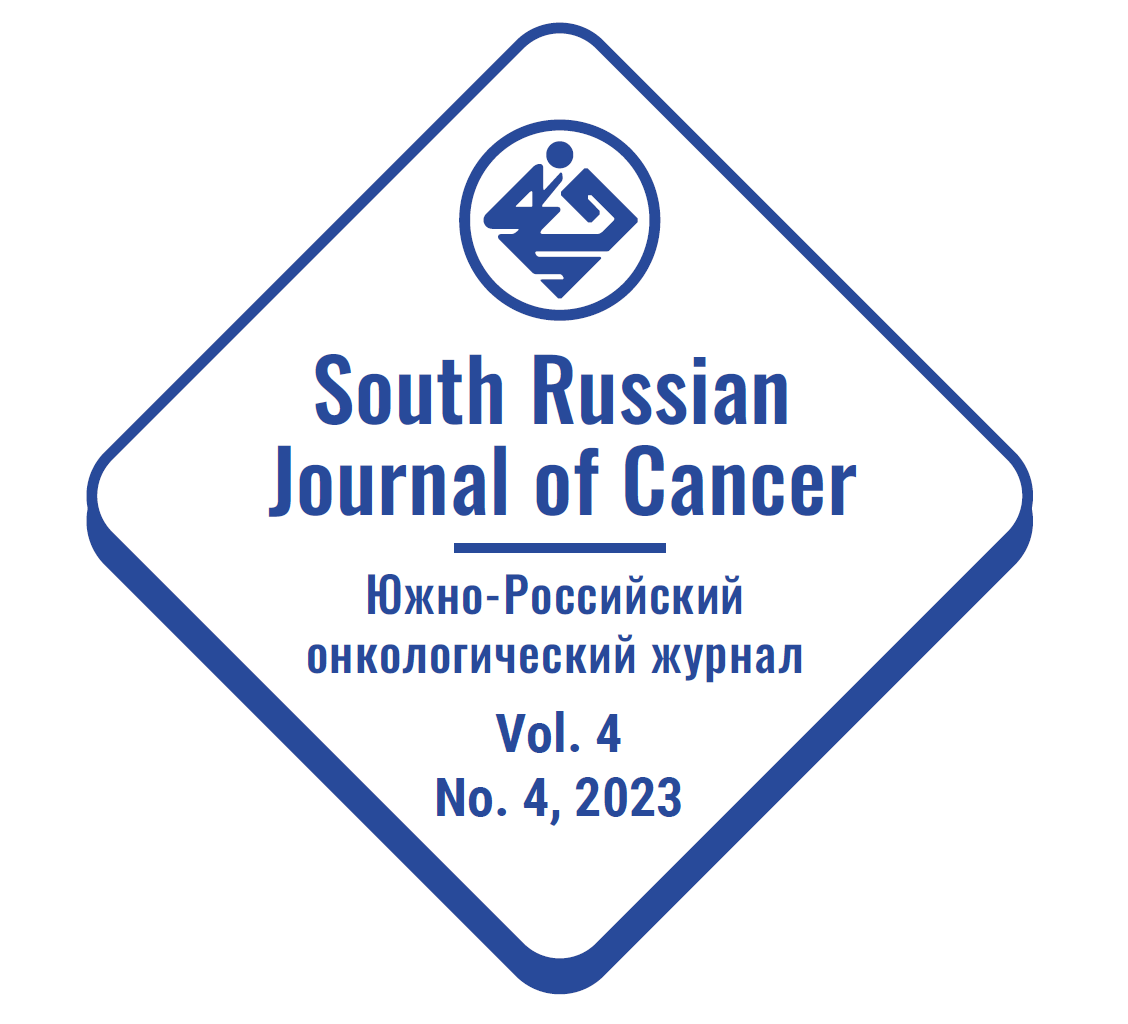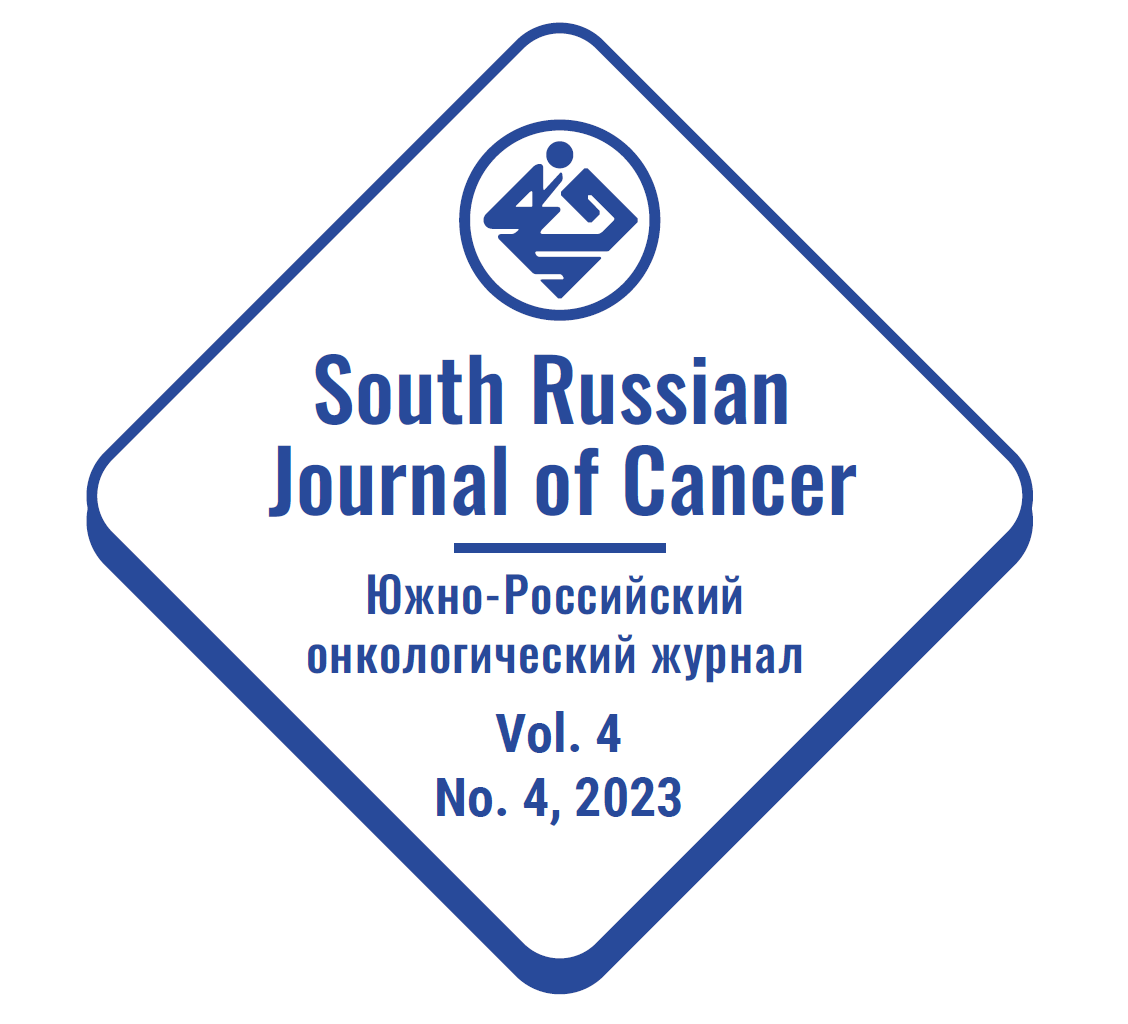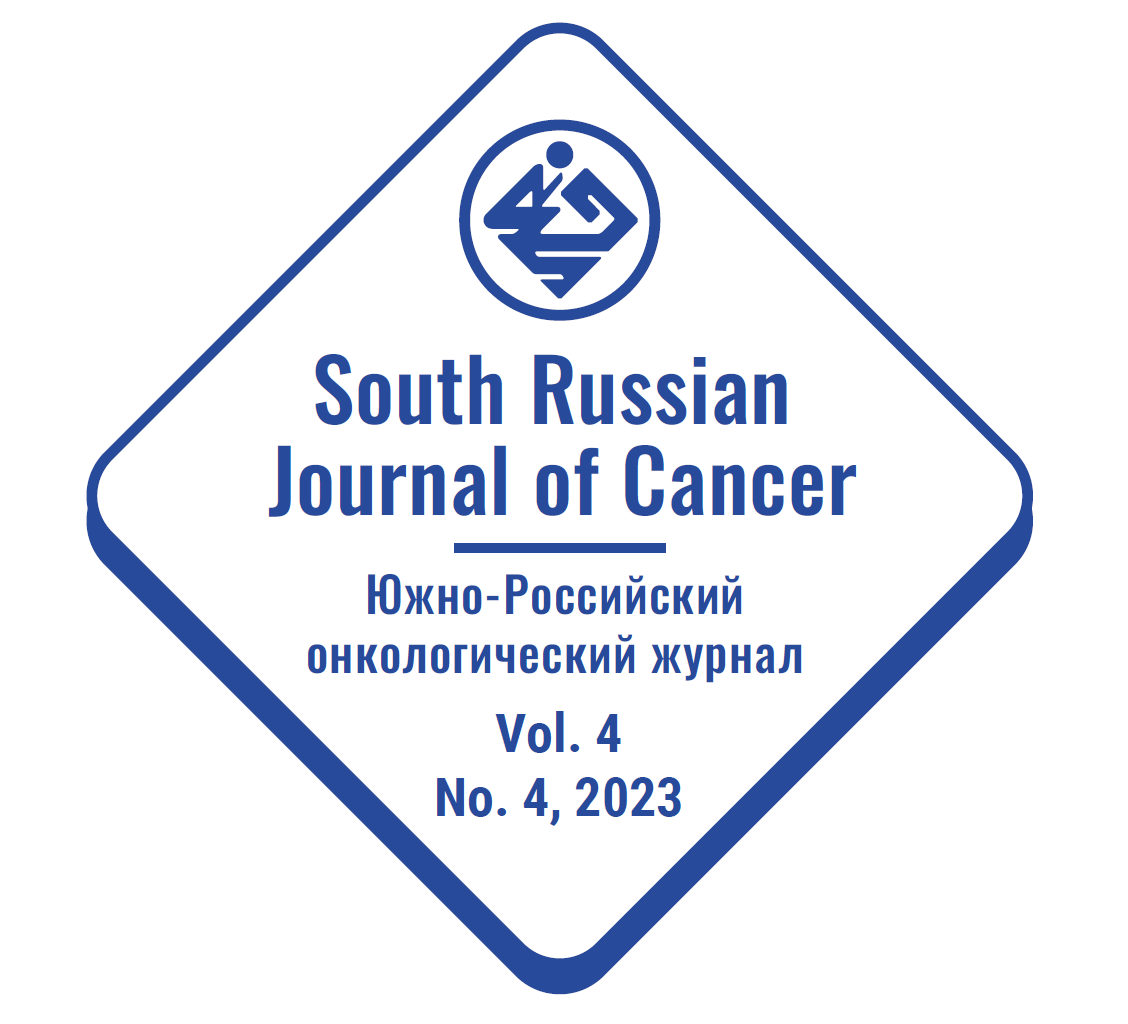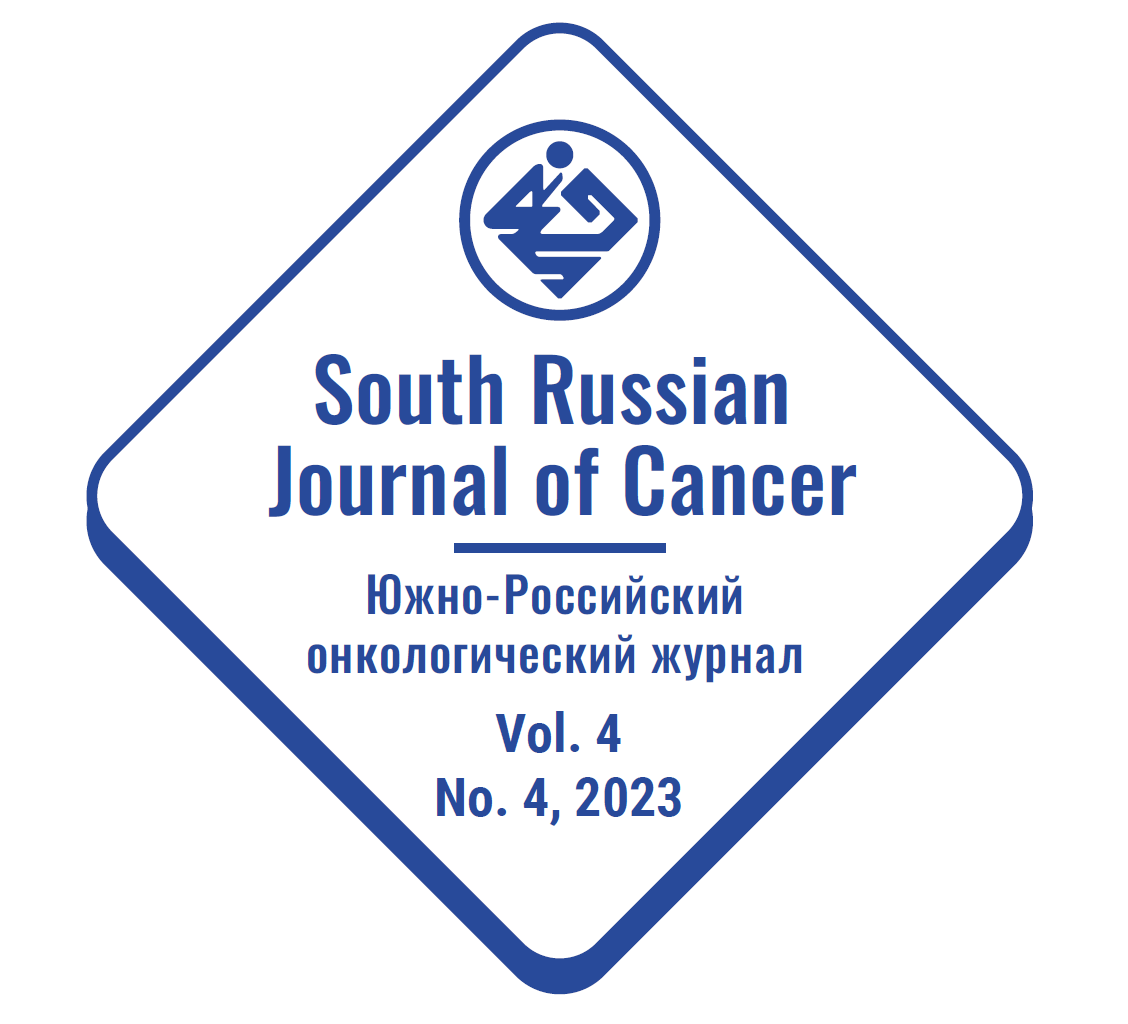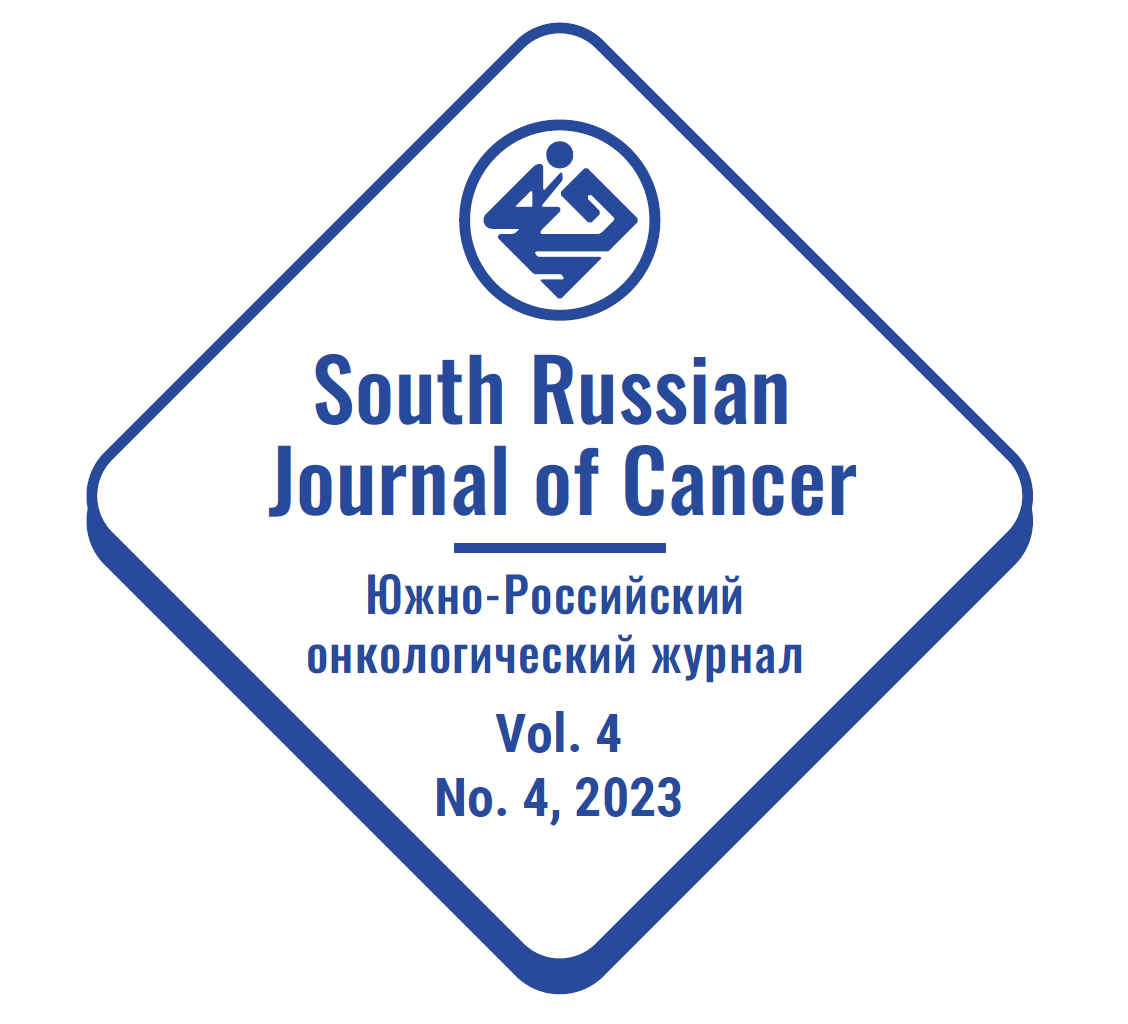ORIGINAL ARTICLES
Purpose of the study. To analyze the immediate outcomes following surgical treatment of locally advanced malignant non-organ retroperitoneal tumors (NRT).
Materials and methods. Surgical interventions for malignant NRTs were performed in 114 patients at Abdominal Oncology Department № 1, National Medical Research Centre for Oncology.There were 48 males and 66 females among them. According to the histological structure, liposarcoma was commonly detected in 64 (56.1 %) cases.
Results. Intraoperative revision revealed the spread of the tumor to adjacent anatomical structures in 67 (58.8 %) cases. Resection surgical interventions were performed in 109 patients, of which 106 (97.2 %) patients had operations performed in an amount of R0. Combined surgical interventions for NRTs were performed in 62 (54.4 %) patients, and multiorgan happened to be in 45 (72.6 %) patients out of those. Resection of the inferior vena cava was performed in 12 patients. Resection of the superior mesenteric vein was performed in 2 patients and the iliac-colonic vein in 2 patients. In 1 observation the left renal vein was resected with suturing of the lateral defect of the vessel wall. Complications during surgery and in the early postoperative period were noted in 14 (12.3 %) patients. In total, 2 patients died after operations, the mortality rate was 1.8 %.
Conclusions. Tumor invasion of big main blood vessels is not a contraindication for surgical treatment of locally spread malignant non-organ retroperitoneal tumors.
Purpose of the study. Was to study the values and variability of traditionally determined blood parameters and index of the adaption status in intact mature Balb/c mice of different sex.
Materials and methods. Studies were carried out on 20 animals of mature age with spf-status, males (10) and females (10). Cytological and biochemical parameters of blood and weight characteristics of the organs of the immune system and adrenal glands were studied (considering the constitutional features of mice of this line). Statistica 10.0 software package was used for statistical analysis. The coefficient of variation (CV) was determined. The significance of statistical differences was assessed using the Mann-Whitney test.
Results. Sex differences were found in the ratio of albumins and globulins, the content of urea and alkaline phosphatase, the relative proportion of lymphocytes and monocytes in the blood count, the erythrocytes’ count and the level of hemoglobin in erythrocytes. There were also indicators which had values of severe variability (CV up to 51 %), the number of those in males was higher than in females. The information content of the weight characteristics of the studied organs is reduced due to the constitutional features of Balb/c females. The identified sex differences indicated a higher adaptive status of female rodents compared to males and let to propose the prevalence of different activity of T-cell, B-cell and myeloid line in animals of different sexes.
Conclusion. The study of weak and moderate shifts in traditional laboratory parameters reflecting the adaptive status and characteristics of the blood of sexually mature males and females of the Balb/c line under physiological conditions made it possible to identify the sex characteristics of systemic regulatory processes that may be important for the body's resistance to malignant growth and the effectiveness of antitumor treatment. The current areas of further research are also indicated.
Purpose of the study. To assess the effect of inclusion of lactoglobulin in complex preoperative preparation of colon cancer patients on their tumor and resection line tissue microbiota.
Materials and methods. 40 patients with colon cancer stages II–III, in whom the operation was the first stage of treatment, during standard preoperative preparation, were injected with a preparation of antibodies against opportunistic intestinal microorganisms obtained from colostrum of immunized cows, 2 g twice a day orally before surgery for 3 days (total dose of 12 g) (main group); 40 patients received standard antibiotic prophylaxis (control group). The quantitative composition of the microbiota was determined in the samples of the removed tumor and tissue of the resection line.
Results. The total microbial contamination of the tumor was 9.2 times lower in the main group relative to the control group; the frequency of E.coli and Clostridiae excretion was also statistically significantly lower (p = 0.004 and 0.03, respectively). In the tumors of patients of the main group out of twelve studied representatives of microorganisms, the number of six was statistically significantly lower than in control group, and three of those found in the control group were not detected. Since they were potentially pathogenic (Pseudomonas aeruginosa, Staphylococcus aureus, fungi of the Candida spp.), the microbial composition of the tumor of patients in the main group can be considered more favorable than the control group. Similar differences were noted in non-t umor intestinal tissue, in which the content of Enterobacter spp, Streptococcus, Clostridiae, Peptostreptococci was statistically significantly lower than in the control group.
Conclusion. Thus oral administration of colostrum antibodies caused positive changes in tumor and colon tissue microbiota. We suggest the application of lactoglobulin to be useful for surgical treatment of such patients taking into account the possible impact of microbiota in patients’ response to chemo- and immunotherapy.
Purpose of the study. Improvement of the prognostic outcomes for the pancreatic fistula development in surgical treatment for pancreatic cancer by implementation of new diagnostic algorithms for magnetic resonance imaging (MRI) assessment of supposed pancreatic stump.
Materials and methods. We performed a retrospective analysis of MRI results of 1136 patients from the medical data base of National Medical Research Centre for Oncology for 2009–2020. An original scanning technique, trans- and cross-pancreatic imaging and MR spectroscopy of the pancreas in patients with pancreatic cancer, was developed and applied. Preoperative examinations were compared retrospectively: a standard MRI protocol without anatomical orientation of the series; MRI protocol using the developed technology.
Results. 717 patients were diagnosed with advanced pancreatic cancer. Lymph nodes were affected in 302 patients among 419 patients with radical surgeries. All cases were confirmed morphologically. In the group of 419 patients with pancreatic resections, based on the analysis of morphological and clinical data and preoperative MRI data, we developed an original preoperative scale for assessing the risk of pancreatic fistula development and compared its accuracy with other intraoperative scales, FRS and modified FRS. Lactate and lipid complex were selected from a wide range of metabolites. The surgical protocols and results of histological examination of the surgical material were used to prove the accuracy of the study. The overall accuracy of the technique in predicting fistula development was 97.5 %. New visual predictors («domino» and «white on white» symptoms) based on MRI data were used to improve the scale accuracy.
Conclusion. The developed method of using a modified scale for risk assessment of pancreatic fistula development allows predicting the onset of early postoperative complications already at the preoperative stage. When comparing the calculated risks of pancreatic fistula according to the developed scale with the results by the known scales (FRS and modified FRS), statistical analysis showed a significant difference for the better when compared with FRS (p = 0.0477), and a tendency when compared with modified FRS (p = 0.0544).
Purpose of the study. A comparative analysis of blood parameters and some characteristics of the adaptation status of intact Balb/c and C57Bl/6 mice of both sexes.
Materials and methods. We investigated intact mice of both sexes belonging to the C57Bl/6 (n = 18) and Balb/c (n = 20) lines. The age characteristics of these animals corresponded to the first half of the reproductive period. We studied the parameters of the complete and biochemical blood tests, the weight characteristics of the thymus, spleen and adrenal glands. The character and tension of general nonspecific adaptational reactions of the body (AR) were assessed as well. In statistical analysis we used the coefficient of variation (CV), Student's t-test, Mann-Whitney test.
Results. In mice of both studied lines, the dominance of females over males was noted in terms of the weight characteristics of the thymus and spleen, the development of the most favorable antistress AR, and the number of indicators with low variability. At the same time, in C57Bl/6 mice, animals of different sexes had a similar nature of AR (AR of elevated activation),but differed in signs of tension, this might indicate the difference in the range of levels of reactivity, appropriate to AR in males and females C57Bl/6. Unlike C57Bl/6, mice Balb/c mice of different sexes were distinguished with the predominant antistress AR. Differences between C57Bl/6 mice and Balb/c mice in terms of amylase and ALT activity indicated a shift towards carbohydrate metabolism in Balb/c mice and a shift towards protein metabolism in C57Bl/6 mice. Animals of the С57Bl/6 line had an advantage over Balb/c mice (especially pronounced in females) in some indicators of the adaptation status.
Conclusion. The results of the study indicated possible difference in the ratio of carbohydrate and protein metabolism in the animals of the studied lines and testified a more favorable state of the regulatory systems in C57Bl/6 mice compared to animals of the Balb/c line. The revealed regulatory and metabolic interlinear differences can determine the features in the reaction of the body of animals belonging to different lines to the malignant process and efficiency of antitumor therapy.
REVIEWS
Low anterior resection syndrome is a common problem due to the increased incidence of rectal cancer and the high incidence of anorectal dysfunction during sphincter-preserving surgical interventions. The influence of functional disorders on the quality of life of patients and changes in social adaptation makes it possible to attribute the syndrome of low anterior resection to topical and discussed issues.
Purpose of the study: to consider the features of the development of anorectal dysfunction in patients with rectal cancer by studying risk factors and pathogenetic aspects of the development of low anterior resection syndrome, as well as to evaluate the role of objective studies in assessing the syndrome according to published literature. The etiology of low anterior resection syndrome is multifactorial. Unmodified and modified predictors are distinguished among the risk factors. Unmodified factors include female gender and age over 65 years. Among the modifiable predictors, radiation therapy, surgical intervention, the type of formed colorectal anastomosis and the development of its insolvency, as well as the elimination of intestinal stoma have a negative effect on anorectal function. Nevertheless, the greatest role in its development is played by organ-preserving surgery with total mesorecumectomy, radiation therapy and the formation of a preventive ileostomy. The complexity of the pathophysiological mechanism of the syndrome necessitates a detailed study of anorectal function and changes in its parameters in patients during treatment for rectal cancer. Functional disorders in low anterior resection syndrome vary in severity. In the study of the severity of clinical manifestations of the syndrome, the use of the LARS scale is important, and in the development of anal incontinence, the use of the Wexner scale is important. However, the most accurate assessment can be carried out by objective research methods, such as high-resolution anorectal manometry. This research method allows to control the function of the rectal obturator apparatus at different stages of combined treatment and unwraps the possibility of searching for new predictors of low anterior resection syndrome.
Esophageal cancer (EC) is one of the most aggressive malignant neoplasms, ranking sixth among oncological causes of death. According to GLOBOCAN, more than half a million people die from this disease every year, and by 2040 this indicator is expected to increase almost twice. In most patients, esophageal cancer is diagnosed at stages III–IV of the disease. Currently, the standard of treatment for inoperable patients with EC is simultaneous chemoradiotherapy.
One of the main methods of treatment of patients with non-metastatic esophageal lesion remains surgical intervention in the volume of esophagectomy with radical lymph dissection, accompanied by quite frequent serious postoperative complications. However, the results of surgical treatment of locally advanced esophageal cancer alone remain unsatisfactory, and the fiveyear survival rate is less than 20 %. In order to improve the oncological results of treatment, various combinations of drug and radiation therapy are used (preoperative chemotherapy or chemoradiotherapy, independent chemoradiotherapy). To date, recommendations for the treatment of locally advanced esophageal cancer vary from country to country. Trimodal therapy (preoperative chemoradiotherapy up to TFD – 46 Gy with 5 cycles of weekly chemotherapy according to the carboplatin + paclitaxel scheme followed by surgical treatment) is the standard in operable patients with non-metastatic squamous cell carcinoma of the esophagus in our and European countries. In Asian countries, preference is given to neoadjuvant chemotherapy, based on the data of the JCOG1109 (NExT) study, in which it was shown that the addition of docetaxel to neoadjuvant therapy with cisplatin and fluorouracil is accompanied by an improvement in overall survival and acceptable toxicity, compared with the CF regimen and chemoradiotherapy. A separate issue is the place of lifesaving esophagectomy in patients who have received a course of radical chemoradiotherapy. Unfortunately, according to several researchers, recurrent or persistent esophageal cancer remains an urgent problem with a risk of relapse of the disease in up to 60 % of cases.
We have studied the data of the Russian and global literature concerning the treatment of squamous cell carcinoma of the esophagus.



